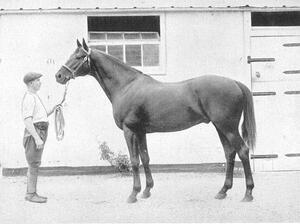Research team led by Göttingen University questions link to warmblood fragile foal syndrome

Credit: From the publication of the natural science collections of the Martin Luther University Halle-Wittenberg
Warmblood fragile foal syndrome is a severe, usually fatal, genetic disease that manifests itself after birth in affected horses. Due to the defect, the connective tissue is unstable. Under force, for instance, the skin tears from the tissue underneath and the joints can suffer dislocation. A research team from the Universities of Göttingen and Halle has now been able to prove that the disease did not stem from the English thoroughbred stallion Dark Ronald XX, which had been the assumption until now. The results have been published in the journal Animal Genetics.
The mystery of the genetic defect could have been solved in 2012: this is when gene responsible was identified. It is called PLOD1 and normally ensures that collagen molecules in the skin and connective tissue can bind to form a stable network. The mutation in the PLOD1 gene prevents “cross-linking” which is needed for stable collagen. The exact origin of the mutation was previously unclear. Since the spread of the genetic defect is also a problem in horse-breeding in Germany, the Vereinigte Informationssysteme Tierhaltung (IT-Solutions for Animal Production) in Verden 2019 determined the possible origin of the genetic defect from the test results of around 2,000 horses and their pedigree records. The investigation concluded that the genetic defect was probably due to the English thoroughbred stallion Dark Ronald XX (1905-1928) or his father, Bay Ronald XX, and the defect was then spread through their offspring. The current research, led by the University of Göttingen, calls this theory into question. “We have now succeeded in proving that Dark Ronald XX was not a carrier of the PLOD1 mutation and can therefore be excluded as the original source of this genetic defect,” says Professor Bertram Brenig, Director of the Institute of Veterinary Medicine at the University of Göttingen and lead author of the study. Doubts about whether the mutation descended from Dark Ronald XX were already expressed in 2019, and further investigation reveals a Hanoverian stallion born in 1861.
Dark Ronald XX was an important thoroughbred stallion who had a great influence on German horse-breeding. He was sold to Germany in 1913 and was used as a stud – a stallion with highly prized heritable characteristics – first in Graditz and later in Altefeld. In 1928, he was brought to the veterinary clinic of the University of Halle for treatment due to intestinal colic and this is where he died. Since then his remains – such as skeleton, heart and skin – have been kept in one of the natural science collections of the Martin Luther University Halle-Wittenberg. “This is most fortunate, as it has allowed us to examine Dark Ronald XX directly for the presence of the PLOD1 mutation,” says Brenig. The scientists were thus able to examine small pieces of Dark Ronald XX’s skin. “Examining the DNA from the nearly 100-year-old skin of Dark Ronald XX was not easy,” says co-author Dr Renate Schafberg from the University of Halle, “because we knew nothing about the tanning or other preservation treatments of the skin.”
The disease itself is not new and probably originated in the middle of the 18th century. Since then, all breeding animals have been consistently tested for the genetic defect. There is a comparable genetic disease in humans, known as Ehlers-Danlos syndrome, which shows similar symptoms.
###
Original publication: Xuying Zhang et al. Skin exhibits of Dark Ronald XX are homozygous wild type at the Warmblood fragile foal syndrome causative missense variant position in lysyl hydroxylase gene PLOD1. Animal Genetics (2020). https:/
Also available at this link: https:/
Contact:
Professor Bertram Brenig
University of Göttingen
Institute of Veterinary Medicine
Division of Molecular Biology of Livestock and Molecular Diagnostics
Burckhardtweg 2, 37077 Göttingen, Germany
Tel.: +49 (0) 551-39 28383
Email: [email protected]
http://www.
Dr Renate Schafberg
Museum für Haustierkunde
der Martin-Luther-Universität Halle-Wittenberg
Adam-Kuckhoff-Strasse 35a
06108 Halle (Saale), Germany
Tel: +49 (0) 345/5522322
Email: [email protected]
Media Contact
Melissa Sollich
[email protected]
Original Source
https:/
Related Journal Article
http://dx.




